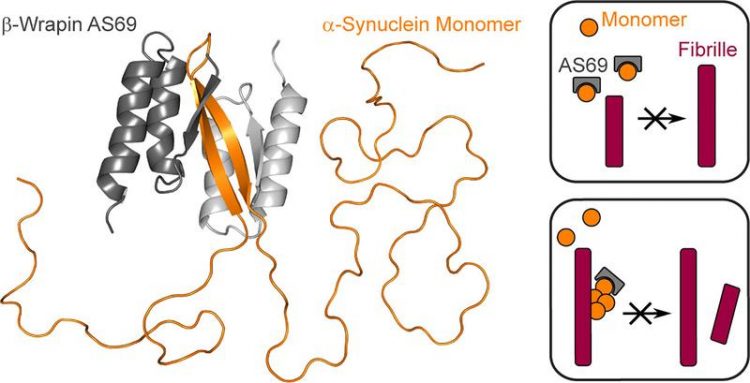Research into Parkinson’s disease: binding-protein prevents fibril proliferation

Aggregation inhibitor beta-wrapin AS69 (grey) binds a region in the otherwise disordered Parkinson’s protein alpha-synuclein (orange), preventing elongation and formation of new protein fibrils (red). HHU / Wolfgang Hoyer
Several neurodegenerative diseases such as Parkinson’s are closely linked to the aggregation of a specific protein, α-synuclein. An international collaborative project involving Heinrich Heine University Düsseldorf (HHU), Forschungszentrum Jülich (FZJ) and RWTH Aachen University has now shed light on the mechanisms used by a specific binding-protein discovered by them to prevent aggregation.
In the journal eLife, they also describe how the binding-protein improves symptoms of Parkinson’s disease in fruit flies.
Protein aggregates have been observed in the nerve tissue of patients with Parkinson’s disease which consist of individual components (monomers) of the protein α-synuclein which assemble into what are referred to as amyloid fibrils.
Similar deposits are also found in the case of other neurodegenerative diseases such as Alzheimer’s. Researchers are looking for approaches to prevent fibril formation and potentially cure the diseases.
In 2014, Düsseldorf-based researchers led by Prof. Dr. Wolfgang Hoyer described how a class of engineered binding-proteins, β-wrapins, are able to prevent α-synuclein aggregation.
Hoyer says: “We subsequently investigated with research partners precisely how the β-wrapins function and where they disrupt the α-synuclein aggregation process.”
The collaborative group including first author of the study Emil D. Agerschou and Prof. Hoyer from the Chair of Physical Biology at HHU and the FZJ, Prof. Dr. Alexander Büll (Technical University of Denmark) and Prof. Dr. Björn Falkenburger (Technical University of Dresden) as well as other partners at the University of Cambridge and the German Center for Neurodegenerative Diseases in Bonn has now presented its findings in the journal eLife.
Firstly, the researchers found out that the β-wrapins prevent new α-synuclein monomers from elongating the amyloid fibrils. To do this, the β-wrapins capture the monomers and form chemical complexes with them.
But there is a further property that makes the β-wrapins particularly effective, as explained by Emil Agerschou: “The β-wrapins prevent seed fibrils from forming in the first place. It is especially relevant that very small amounts of the wrapins are sufficient for this to happen, so you don’t need a binding-protein for every monomer.”
This is referred to as a ‘sub-stoichiometric effect’ that makes the process especially effective. It is the aforementioned complexes comprising binding-proteins and monomers that are responsible for inhibiting seed formation.
“We discovered a few years ago that α-synuclein fibrils can proliferate quickly under certain conditions in a kind of chain reaction. We were really astonished to see that the β-wrapins suppress the chain reactions very efficiently”, adds Prof. Büll: “We think we now understand how this is achieved.”
In addition, the researchers have examined the effect of the β-wrapins not only in test tubes but also in cell culture and in animal models. Diseased fruit flies (Drosophila) treated with β-wrapins displayed notably improved motor skills in a climbing assay.
Prof. Hoyer is still cautious about potential therapeutic use: “The positive results in living creatures give us hope that we have possibly found a path to an active ingredient through the β-wrapins. However, it will still be a long time before this could potentially be used for humans.”
E. D. Agerschou, T. Saridaki, P. Flagmeier, C. Galvagnion, D. Komnig, L. Heid, V. Prasad, H. Shaykhalishahi, D. Willbold, C. M. Dobson, A. Voigt, B. H. Falkenburger, W. Hoyer, A. K. Buell, An engineered monomer binding-protein for α-synuclein efficiently inhibits the proliferation of amyloid fibrils, eLife 2019;8:e46112
DOI: 10.7554/eLife.46112
Media Contact
More Information:
http://www.hhu.de/All latest news from the category: Life Sciences and Chemistry
Articles and reports from the Life Sciences and chemistry area deal with applied and basic research into modern biology, chemistry and human medicine.
Valuable information can be found on a range of life sciences fields including bacteriology, biochemistry, bionics, bioinformatics, biophysics, biotechnology, genetics, geobotany, human biology, marine biology, microbiology, molecular biology, cellular biology, zoology, bioinorganic chemistry, microchemistry and environmental chemistry.
Newest articles

NASA: Mystery of life’s handedness deepens
The mystery of why life uses molecules with specific orientations has deepened with a NASA-funded discovery that RNA — a key molecule thought to have potentially held the instructions for…

What are the effects of historic lithium mining on water quality?
Study reveals low levels of common contaminants but high levels of other elements in waters associated with an abandoned lithium mine. Lithium ore and mining waste from a historic lithium…

Quantum-inspired design boosts efficiency of heat-to-electricity conversion
Rice engineers take unconventional route to improving thermophotovoltaic systems. Researchers at Rice University have found a new way to improve a key element of thermophotovoltaic (TPV) systems, which convert heat…



